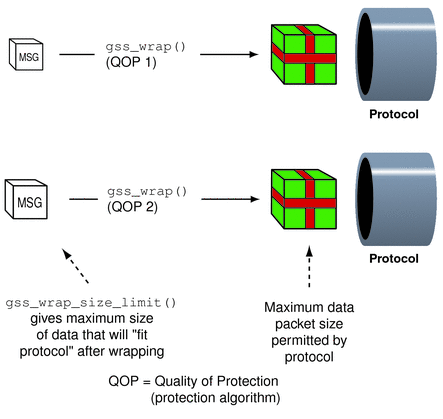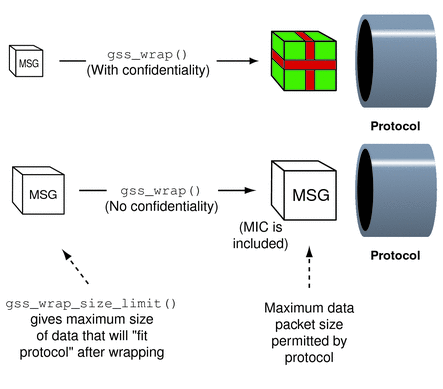Handling Wrap Size Issues in GSS-API
Wrapping a message with gss_wrap() increases the amount of data to be sent. Because the protected message packet needs to fit through a given transportation protocol, GSS-API provides the function gss_wrap_size_limit(). gss_wrap_size_limit() calculates the maximum size of a message that can be wrapped without becoming too large for the protocol. The application can break up messages that exceed this size before calling gss_wrap(). Always check the wrap-size limit before actually wrapping the message.
The amount of the size increase depends on two factors:
-
Which QOP algorithm is used for making the transformation
-
Whether confidentiality is invoked
The default QOP can vary from one implementation of GSS-API to another. Thus, a wrapped message can vary in size even if the QOP default is specified. This possibility is illustrated in the following figure.

Regardless of whether confidentiality is applied, gss_wrap() still increases the size of a message. gss_wrap() embeds a MIC into the transmitted message. However, encrypting the message can further increase the size. The following figure shows this process.

GSS_S_COMPLETE is returned if gss_wrap_size_limit() completes successfully. If the specified QOP is not valid, GSS_S_BAD_QOP is returned. Wrapping and Sending a Message includes an example of how gss_wrap_size_limit() can be used to return the maximum original message size.
Successful completion of this call does not necessarily guarantee that gss_wrap() can protect a message of length max-input-size bytes. This ability depends on the availability of system resources at the time that gss_wrap() is called. For more information, see the gss_wrap_size_limit(3GSS) man page.
- © 2010, Oracle Corporation and/or its affiliates
